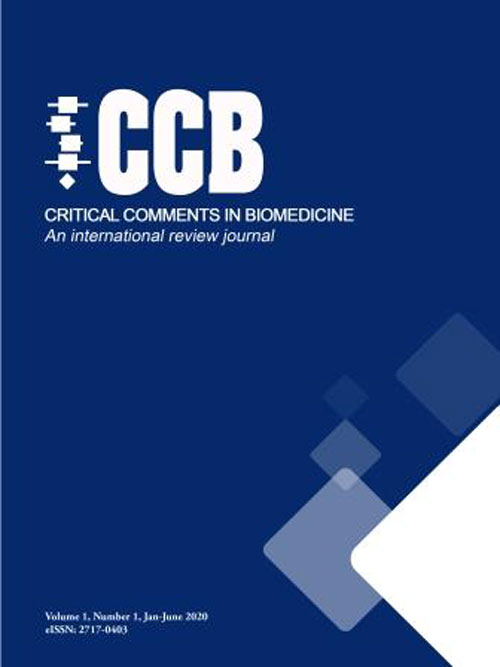فهرست مطالب
Critical Comments in Biomedicine
Volume:1 Issue: 2, Summer Autumn 2020
- تاریخ انتشار: 1399/12/11
- تعداد عناوین: 7
-
-
Page 1
No Abstract
Keywords: Vitamin D, Nutrition, COVID-19 -
Page 3Background & aims
It is proposed that vitamin D supplementation might influence serum adipokines level; however, the recent meta-analyses have led to inconsistent results while they had methodological limitations. Therefore, this study aimed to examine the effects of vitamin D supplementation on serum adipokines through a systematic review and a meta-analysis of randomized placebo-controlled trials (RCTs) using a more comprehensive search strategy.
MethodsPubMed, Google Scholar, and Scopus were searched to identify related articles published up to November 2017. Mean±standard deviation (SD) of changes in serum adiponectin and leptin were extracted, and the effect sizes were pooled using a random-effects model. Studies with Controlled clinical trials design were eligible. Two reviewers extracted mean values and SDs of the baseline, final and net change values of leptin and adiponectin in the intervention and control groups.
ResultsThe pooled results indicated that vitamin D supplementation affects neither circulating leptin (Hedges’ g = 0.042, 95% CI: -0.294 to 0.378, p = 0. 0.807, n=15) nor adiponectin (Hedges’ g = -0.034, 95% CI: -0.243 to 0.174, p = 0.748, n=18) levels. Subgroup analysis showed that vitamin D supplementation might significantly decrease serum leptin level in patients with end stage renal disease (Hedges’ g = -0.634, 95 % CI: -1.221 to -0.047, p = 0.034).
ConclusionsAlthough the current evidence does not support the significant effect of vitamin D supplementation on adiponectin and leptin levels, further research is required to reach more definitive conclusions.
Keywords: Vitamin D, Leptin, Adiponectin, Systematic review, Meta-analysis -
Page 4Background
One of the most common causes of mortality in critical patients admitted to the intensive care unit (ICU) is sepsis. In recent years, the administration of high doses of vitamin C and HAT (hydrocortisone, ascorbic acid and thiamine) therapy has attracted much attention in patients with sepsis.
ObjectivesThe current article reviews the beneficial effects of HAT therapy in light of research conducted in this area.
MethodsA general search for electronic databases was developed. The human studies of the influence of HAT therapy in critically ill patients were evaluated.
ResultsThe results indicated that HAT therapy may improve clinical outcome in septic patients; however, widespread use of these therapeutic approaches in sepsis requires large clinical trials in order to more confidently recommend this therapeutic approach in septic patients admitted to intensive care units.
ConclusionsHAT therapy may improve clinical outcome in septic critically ill patients.
Keywords: Vitamin C, Hydrocortisone, Thiamine, HAT Therapy, Intensive Care Unit, Critical Ill Patients -
Page 6Background
It is suggested that palm oil consumption might increase the likelihood of developing chronic diseases including cardiovascular disease. Previous studies that investigated the effect of palm oil intake on anthropometric measures, blood glucose control, inflammation, and oxidative stress markers were inconclusive. This is while previous systematic review and meta-analyses should be updated.
ObjectivesThe present study describes a protocol for a range of systematic reviews and meta-analyses to examine the effect of palm oil intake on body weight and fat, inflammatory markers, oxidative stress, liver enzymes, blood pressure, and blood glucose control indices.
MethodsISI web of science, EMBASE, MEDLINE, Scopus, and Google Scholar will be searched using medical subject heading (MeSH) and non-MeSH keywords. Controlled clinical trials will be selected based on predefined eligibility criteria. The intra-study risk of bias will be checked by using the Cochrane collaboration's tool. Mean difference (MD) (the difference between mean change values in the intervention group/period and control group/period) and its corresponding standard deviation will be calculated to be used as effect size. A random-effects meta-analysis will be performed to pool the results. Subgroup analysis and meta-regression will be conducted to explore the possible sources of heterogeneity. Sensitivity analysis will be conducted by removing the studies one-by-one from the overall analyses. Publication bias will be assessed by inspecting funnel plots and using asymmetry tests.
ConclusionThe results of systematic reviews and meta-analyses might provide helpful data about the effects of palm oil consumption on different aspects of health among adults. The evidence provided by the results of systematic reviews can be useful for dietitians, clinicians, public health policy-makers, and the public.
Keywords: Palm oil, Body weight, Body composition, Blood pressure, Inflammation, Blood glucose control, Systematic review -
Page 7Background
This study protocol outlines the planned, systematic review and dose-response meta-analysis of nuts intake in relation with cancer risk and its mortality.
MethodsThis meta-analysis will be done based on the Preferred Reporting Items for Systematic Reviews and Meta-Analysis Protocols (PRISMA-P). A systematic literature search will be conducted using online databases, including PubMed/Medline, ISI Web of Science, and Scopus with no limitation in language or time of publication to identify observational studies investigating the association of nuts intake with cancer risk and its mortality. The target population will be adults (≥18 years of age). Random-effects models will be used to calculate pooled effect sizes (ESs) for the risk of cancer and its mortality based on the comparison between the highest and lowest categories of nut intake and to incorporate variation between studies. Linear and non-linear dose-response analyses will be done to evaluate the dose-response associations between nut intake and risk of cancer and its mortality. The Newcastle-Ottawa Scale (NOS) will be used to assess the risk of bias or quality of included studies.
ConclusionThe findings of this systematic review and dose-response meta-analysis will summarize the available evidence on the association between nut intake and risk of cancer and its mortality.
Keywords: Nut, cancer, mortality, Diet, Meta-analysis


